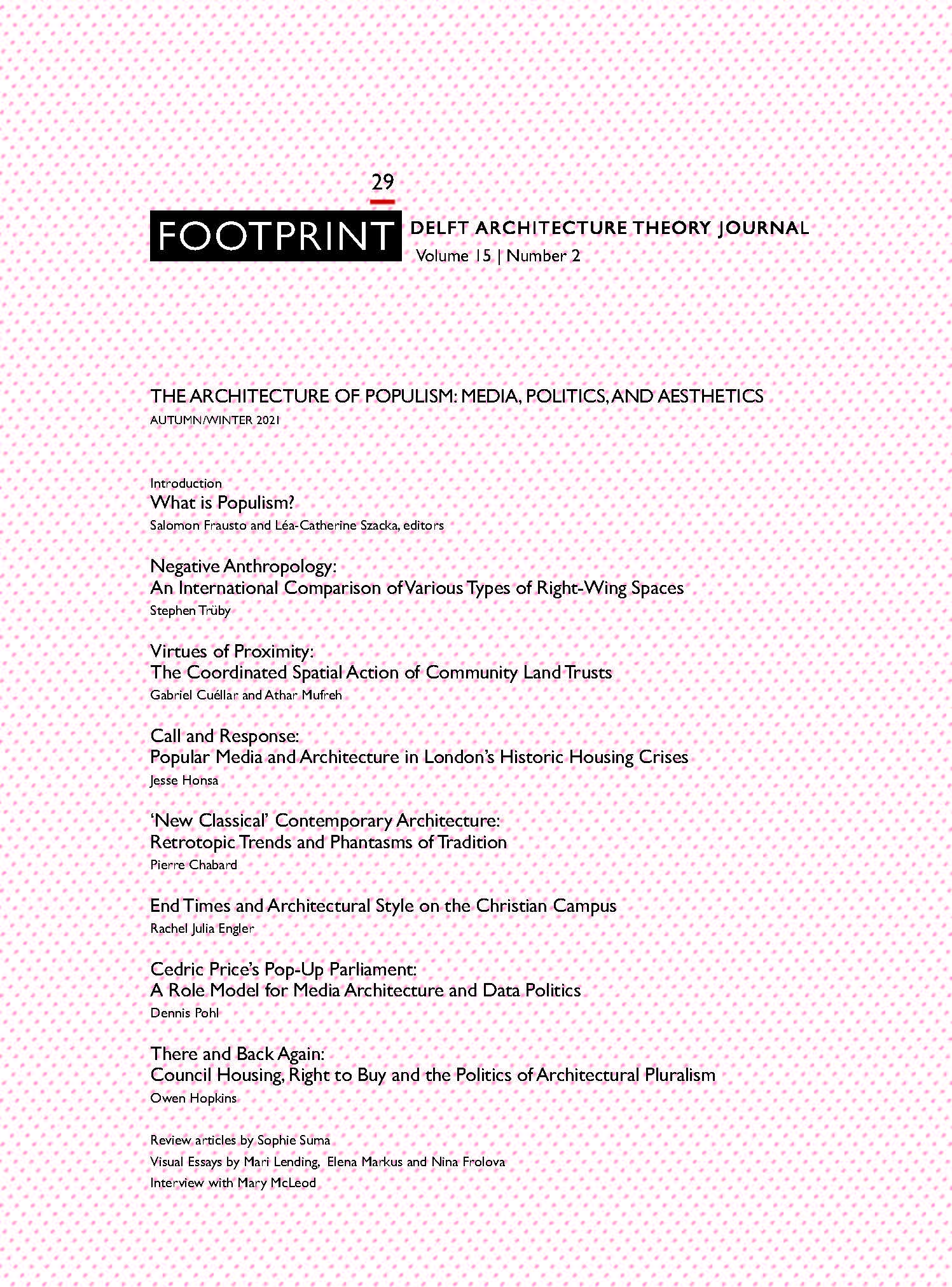End Times and Architectural Style on the Christian Campus
DOI:
https://doi.org/10.7480/footprint.15.2.6132Abstract
This paper examines the idea of architectural style on evangelical Christian campuses built during the Cold War, a period during which religious cosmologies came into contact with the prospect of nuclear disaster, allowing for a temporary alliance between secular and religious visions of the end of human history. In this context of Cold War-era end-of-the-world thinking, and in relation to the biblical anticipation of the apocalypse, I consider the contrasting choices of so-called futuristic and neo-vernacular idioms in the building projects of television evangelists. What does it mean to revive styles of the past, or to build in a mode oriented toward the future, when the end of history is imminent? Design undertaken within the framework of assumed apocalyptic narratives troubles notions of permanence and durability—historically vital terms for thinking about building. The paper takes two primary case studies: Robertson’s Regent University in Virginia Beach, which hosts the Christian Broadcasting Network and was built in a “Jeffersonian” vernacular; and Oral Roberts’s Tulsa university, unique at the time for its gilded modernism.
References
Avery Smith, Matthew, American Apocalypse (Cambridge, MA: Harvard University Press, 2014).
Blake, Peter, ‘Slaughter on 6th Avenue’, Architectural Forum 122 (June 1965): 13–19.
Boyer, Paul, ‘The Growth of Fundamentalist Apocalyptic in the United States’, in Apocalypticism in the Modern Period and the Contemporary Age, vol. 3 of The Encyclopedia of Apocalypticism, ed. Stephen J. Stein (New York: Continuum, 1998), 140.
Boyer, Paul, When Time Shall Be No More: Prophecy Belief in Modern American Culture (Cambridge, MA: Belknap Press of Harvard University Press, 1992).
Burchard, John Ely, ‘Architecture in the Atomic Age’, Architectural Record 116, no. 6 (December 1954): 120.
Clouse, Robert G., ‘The New Christian Right, America, and the Kingdom of God’, in Modern American Protestantism and Its World, vol. 10 of Fundamentalism and Evangelicalism, ed. Martin E. Marty (Munich: K. G. Saur, 1993), 281, 285.
Dabney, Dick, ‘God’s Own Network: The TV Kingdom of Pat Robertson’, Harper’s, 1 August 1980, 34.
Fiske, Edward B., ‘The Oral Roberts Empire’, New York Times Magazine, 22 April 1973.
Greenspan, Ander, Creating Colonial Williamsburg, (Washington: Smithsonian Institution Press, 2002).
Malo, Sebastian, ‘Nearly 500 U.S. Churches Face Climate-linked Flooding Threat, Scientists Say,’ Reuters, 2 May 2019.
Martin, William, ‘Waiting for the End: The Growing Interest in Apocalyptic Prophesy’, The Atlantic, June 1982, 31–37.
Marty, Martin E., ‘The Future of No Future: Frameworks of Interpretation’, in Apocalypticism in the Modern Period and the Contemporary Age, vol. 3 of The Encyclopedia of Apocalypticism, ed. Stephen J. Stein (New York: Continuum, 1998), 461.
McClain, Alva J., ‘Premillenialism as a Philosophy of History’, in Understanding the Times: Prophetic Messages Delivered at the 2nd International Congress on Prophecy, New York City, ed. William Culbertson and Herman B. Centz (Grand Rapids, MI: Zondervan Publishing House, 1956), 23–24.
Moses, Robert, ‘Notes and Comments on a Brief Visit to Tulsa’, Newsday, 16 March 1968, 14.
Roberts, Oral, The Drama of the End-Time (Tulsa: Oral Roberts, 1963)..
Strozier, Charles, Apocalypse: On the Psychology of Fundamentalism in America (Boston: Beacon Press, 1994).
Weber, Timothy P., Living in the Shadow of the Second Coming: American Premillennialism, 1875–1925 (New York: Oxford University Press, 1979).
Wojcik, Daniel, The End of the World As We Know It: Faith, Fatalism, and Apocalypse in America (New York: New York University Press, 1997).
Downloads
Published
Issue
Section
License
Copyright (c) 2022 Rachel Engler

This work is licensed under a Creative Commons Attribution 4.0 International License.
- Authors retain copyright and grant the journal right of first publication with the work simultaneously licensed under a Creative Commons Attribution License that allows others to share the work with an acknowledgement of the work's authorship and initial publication in this journal.
- Authors are able to enter into separate, additional contractual arrangements for the non-exclusive distribution of the journal's published version of the work (e.g., post it to an institutional repository or publish it in a book), with an acknowledgement of its initial publication in this journal.





